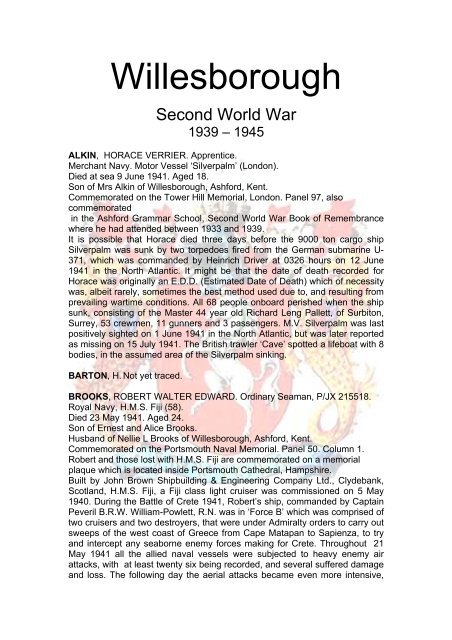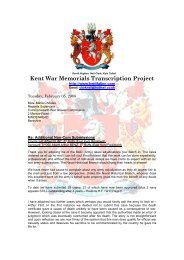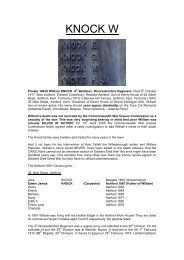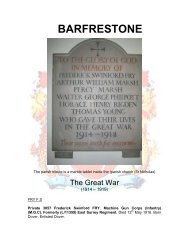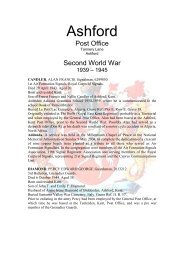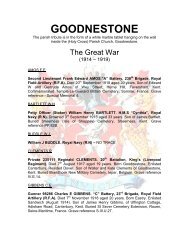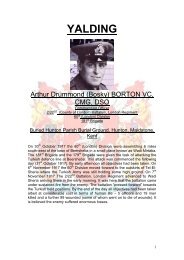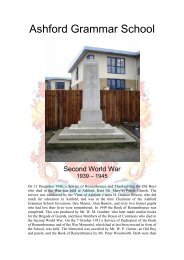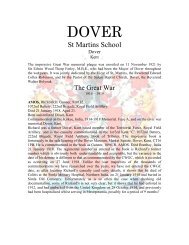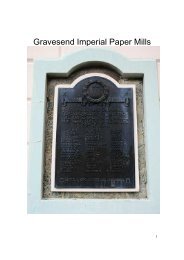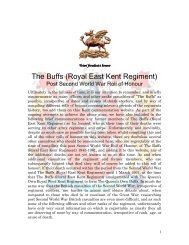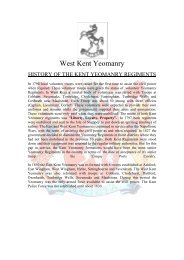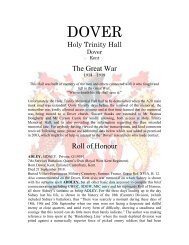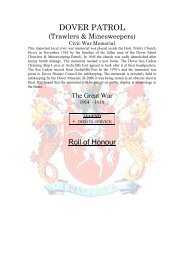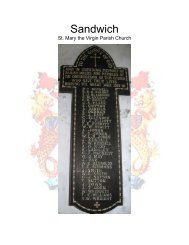Willesborough - Kent Fallen
Willesborough - Kent Fallen
Willesborough - Kent Fallen
You also want an ePaper? Increase the reach of your titles
YUMPU automatically turns print PDFs into web optimized ePapers that Google loves.
<strong>Willesborough</strong><br />
Second World War<br />
1939 – 1945<br />
ALKIN, HORACE VERRIER. Apprentice.<br />
Merchant Navy. Motor Vessel ‘Silverpalm’ (London).<br />
Died at sea 9 June 1941. Aged 18.<br />
Son of Mrs Alkin of <strong>Willesborough</strong>, Ashford, <strong>Kent</strong>.<br />
Commemorated on the Tower Hill Memorial, London. Panel 97, also<br />
commemorated<br />
in the Ashford Grammar School, Second World War Book of Remembrance<br />
where he had attended between 1933 and 1939.<br />
It is possible that Horace died three days before the 9000 ton cargo ship<br />
Silverpalm was sunk by two torpedoes fired from the German submarine U-<br />
371, which was commanded by Heinrich Driver at 0326 hours on 12 June<br />
1941 in the North Atlantic. It might be that the date of death recorded for<br />
Horace was originally an E.D.D. (Estimated Date of Death) which of necessity<br />
was, albeit rarely, sometimes the best method used due to, and resulting from<br />
prevailing wartime conditions. All 68 people onboard perished when the ship<br />
sunk, consisting of the Master 44 year old Richard Leng Pallett, of Surbiton,<br />
Surrey, 53 crewmen, 11 gunners and 3 passengers. M.V. Silverpalm was last<br />
positively sighted on 1 June 1941 in the North Atlantic, but was later reported<br />
as missing on 15 July 1941. The British trawler ‘Cave’ spotted a lifeboat with 8<br />
bodies, in the assumed area of the Silverpalm sinking.<br />
BARTON, H. Not yet traced.<br />
BROOKS, ROBERT WALTER EDWARD. Ordinary Seaman, P/JX 215518.<br />
Royal Navy, H.M.S. Fiji (58).<br />
Died 23 May 1941. Aged 24.<br />
Son of Ernest and Alice Brooks.<br />
Husband of Nellie L Brooks of <strong>Willesborough</strong>, Ashford, <strong>Kent</strong>.<br />
Commemorated on the Portsmouth Naval Memorial. Panel 50. Column 1.<br />
Robert and those lost with H.M.S. Fiji are commemorated on a memorial<br />
plaque which is located inside Portsmouth Cathedral, Hampshire.<br />
Built by John Brown Shipbuilding & Engineering Company Ltd., Clydebank,<br />
Scotland, H.M.S. Fiji, a Fiji class light cruiser was commissioned on 5 May<br />
1940. During the Battle of Crete 1941, Robert’s ship, commanded by Captain<br />
Peveril B.R.W. William-Powlett, R.N. was in ‘Force B’ which was comprised of<br />
two cruisers and two destroyers, that were under Admiralty orders to carry out<br />
sweeps of the west coast of Greece from Cape Matapan to Sapienza, to try<br />
and intercept any seaborne enemy forces making for Crete. Throughout 21<br />
May 1941 all the allied naval vessels were subjected to heavy enemy air<br />
attacks, with at least twenty six being recorded, and several suffered damage<br />
and loss. The following day the aerial attacks became even more intensive,
with at least 67 being recorded. ‘Force B’ as with all other similar naval<br />
formations suffered damage and loss, the light cruiser H.M.S. Gloucester<br />
commanded by Captain H.A. Rowley, D.S.O., R.N. was sunk in the<br />
Antikythera Channel, about 15 nautical miles west of Antikythera Island,<br />
Greece in position by German Ju-88 and Ju-87 bombers at approximately<br />
1600 hours, and Robert’s ship at about 1900 hours. H.M.S. Fiji, after having<br />
survived some 20 bombing attacks in four hours, was initially hit by a bomb<br />
from a single Messerschmitt Me 109 aircraft which flew out of the clouds in a<br />
shallow dive and scored a hit very close to the ships port side amidships,<br />
when she was approximately 45 nautical miles south-west of Crete. Although<br />
badly damaged, H.M.S. Fiji was still able to steam at a reduced speed until<br />
half an hour later, when another single enemy aircraft dropped three bombs<br />
which scored direct hits on Robert’s stricken ship, and she had to be<br />
abandoned after developing a heavy list and sank within five hours with the<br />
loss of 17 officers and 224 ratings. Two Royal Navy destroyers H.M.S.<br />
Kandahar commanded by Commander W.G.A. Robson, D.S.O., R.N., and<br />
H.M.S. Kingston commanded by Commander P. Sommerville, D.S.O., D.S.C.,<br />
R.N. picked up 533 survivors from Robert’s ship, of which some later died of<br />
their injuries, and as such it would seem likely that Robert was sadly amongst<br />
their number. There is also the possibility that Robert died resulting from an<br />
injury from the time when his ship was put out of commission for six months<br />
following an attack on her by the German submarine U-32 on 1 September<br />
1940, in view of the fact that Robert is commemorated on the Portsmouth<br />
Naval Memorial, the former seems the most plausible. It seems right in this<br />
brief tribute to Robert too also briefly make mention of his ships 32 year old<br />
Padre, the Reverend Christopher Champain A.M. who gave his life by<br />
repeatedly diving into the sea to rescue sailors from certain death, he was an<br />
England Rugby player, and not surprisingly the only one of the team to be<br />
awarded the Albert Medal. Captain Peveril B.R.W. William-Powlett, K.C.B.,<br />
K.C.M.G., C.B.E., D.S.O., R.N. (1898-1985) fortunately survived the sinking of<br />
H.M.S. Fiji and was the Governor of Southern Rhodesia from 1954 to 1959.<br />
BURKE, R.E. No Clear trace. Five casualties are commemorated by the<br />
CWGC, for of whom show home and family details, non of which is relevant to<br />
Ashford or indeed the county of <strong>Kent</strong>. The remaining casualty has been<br />
entered below, as he appears to be the best match. Caution is advised<br />
however regarding accuracy, should anybody at some future date carry out<br />
more detailed research into the war memorial or this casualty in particular.<br />
BURKE, ROBERT EDWARD. Sailor.<br />
Merchant Navy, S.S. San Gerardo (London).<br />
Died 31 March 1942. Aged 18.<br />
Commemorated on the Tower Hill Memorial, London. Panel 92.<br />
At 2222 hours on 31 March 1942, the unescorted 12915 ton steam tanker<br />
S.S. San Gerardo commanded by 44 year old Master Stanley Foley, was hit<br />
by two torpedoes fired from the German submarine U-71 and sank by the<br />
stern southeast of New York, U.S.A. The tankers master, 47 crew members,<br />
two D.E.M.S. gunners and one passenger were lost. Three crew members<br />
and three gunners were picked up by the British tanker Regent Panther and<br />
landed at Halifax, Nova Scotia. At the time of her loss the tanker built in 1922<br />
by Palmers Shipbuilding & Iron Co Ltd, of Jarrow and Hebburn-on-Tyne, was
owned by the Eagle Oil & Shipping Co Ltd, of London, and was laden with<br />
17000 tons of fuel oil en-route from Curacao for Halifax. In command of the U-<br />
71 was 33 year old Kapitänleutnant, Walter Flachsenberg, who was promoted<br />
to Korvettenkapitän on 1 July 1942. A native of Mönchen-Gladbach,<br />
Germany, Walter Flachsenberg survived the Second World War and died on 3<br />
November 1994, aged 86.<br />
BUTLER, JOHN ERNEST. Gunner, 1698062.<br />
474 Battery, 76 Searchlight Regiment, Royal Artillery.<br />
Died 14 November 1944. Aged 28.<br />
Born <strong>Kent</strong>. Resided South West London.<br />
Son of Henry Edgar and Selina Rose Butler of <strong>Willesborough</strong>, Ashford, <strong>Kent</strong>.<br />
Buried Ashford (<strong>Willesborough</strong>) Cemetery. Grave Ref: Section O. Grave 152.<br />
Possibly John had been ill or injured for some time prior to his demise,<br />
because his unit was disbanded in September 1944, having been engaged in<br />
airfield defence as part of the 64 Anti-Aircraft Brigade since July 1940.<br />
CAPELING, WILLIAM KEITH. Sub-Lieutenant (A).<br />
H.M.S. Saker, Royal Naval Volunteer Reserve.<br />
Died 30 April 1944. Aged 20.<br />
Son of William Frederick and Jessie Alice Capeling of Ashford, <strong>Kent</strong>.<br />
William is commemorated in the Ashford Grammar School Book of<br />
Remembrance where he was a pupil between 1934 and 1939.<br />
Buried Portsmouth Naval Cemetery, New Hampshire, U.S.A. Grave Ref: Lot<br />
162.<br />
At the time of William’s demise, H.M.S. Saker was a Fleet Air Arm accounting<br />
base in Washington D.C., U.S.A., having been commissioned on 1 October<br />
1941 and remained as such until 1948. William died in an aircraft accident<br />
which occurred at Bar Harbour, Maine, U.S.A.<br />
CHITTENDEN, EDWARD ANTHONY GEORGE. Boy 1st Class, C/JX166822.<br />
Royal Navy, H.M.S. Naiad (93).<br />
Died 11 March 1942. Aged 17.<br />
Son of Alfred and Lillian Chittenden of Brightside, Sheffield, Yorkshire.<br />
Commemorated on the Chatham Naval Memorial. Panel 58. Column 2.<br />
H.M.S. Naiad a 5,450 ton Dido class light cruiser commanded by Captain G<br />
Grantham R.N. was torpedoed and sunk between Mersa Matruh and Sollum<br />
at 2001 hours by the German submarine U-565, commanded by 23 year old<br />
Kapitänleutnant Johann Jebsen. Edward’s ship and other vessels were<br />
returning to Alexandria, Egypt after a search for an Axis convoy heading for<br />
Libya. Although 82 perished, 582 survived the sinking mainly due to the<br />
intervention of an American ship. At the time of the sinking H.M.S. Naiad had<br />
been the Flagship of Philip Vian, who later became an Admiral of the Fleet Sir<br />
Philip Vian G.C.B., K.B.E., D.S.O. (1894-1968). Johann Jebsen and his crew<br />
had left La Spezia, Italy on 21 January 1942, to undertake an eight week<br />
patrol; H.M.S. Naiad was the only ship that the U-565 sunk on the patrol, prior<br />
to returning to La Spezia on 17 March 1942. Johann Jebsen, a native of<br />
Pellworm, died on 23 September 1944, in the Indian Ocean, off Penang, Strait<br />
of Malacca whilst in command of the U-859, which was sunk by the Royal<br />
Navy submarine H.M.S. Trenchant (P331).
COLEMAN, FREDERICK THOMAS WALTER. Lance Corporal, 6288418.<br />
4th Battalion. The Buffs (Royal East <strong>Kent</strong> Regiment).<br />
Died between 13 and 16 November 1943. Aged 25.<br />
Born and resided <strong>Kent</strong>.<br />
Son of Robert and Emma Jane Coleman of 24 Kennington Road,<br />
<strong>Willesborough</strong> Lees, Ashford, <strong>Kent</strong>.<br />
Buried Leros War Cemetery, Greece. Grave Ref: 3. A. 5.<br />
Pre war member of The Buffs (Royal East <strong>Kent</strong> Regiment).<br />
Frederick was a pupil at the Ashford, <strong>Kent</strong> North County Modern (Boys)<br />
School 1929-1932. For most of the Second World War, his service had been<br />
overseas prior to his death, having served in France 1939-1940, followed by<br />
Malta 1940-1943. Later in 1943, Frederick fought and died during the<br />
disastrous Dodecanese Expedition on Crete, having left Alexandria, Egypt<br />
aboard H.M.S. Petard on 22 October 1943, and no doubt helping in the<br />
rescue of some of his comrades, when H.M.S. Eclipse was sunk after hitting a<br />
mine. Having arrived safely at Leros, the battalion and everybody else on the<br />
island were subjected to a massive increase in enemy air offensives which<br />
became heavier from 13 November with enemy sorties then averaging about<br />
eighty a day, causing havoc with the infrastructure and a high casualty rate<br />
amongst the defenders including to Frederick’s battalion. It is likely that<br />
Frederick lost his life resultant of the enemy air attacks.<br />
COLLINS, DAVID WILLIAM. Private, 6288233.<br />
5th Battalion, The Buffs (Royal East <strong>Kent</strong> Regiment).<br />
Died 21 May 1940. Aged 24.<br />
Born and resided <strong>Kent</strong>.<br />
Son of William and Nellie Collins.<br />
Husband of Elsie I Collins of Ashford, <strong>Kent</strong>.<br />
Also commemorated in Christchurch Church South Ashford, <strong>Kent</strong>, and on the<br />
Dunkirk Memorial, Nord, France. Column 38.<br />
Pre war member of The Buffs (Royal East <strong>Kent</strong> Regiment).<br />
CRITTENDEN, JAMES ALFRED. Leading Stoker, CK/X80025.<br />
Royal Navy, H.M.S. Orion.<br />
Died 29 May 1941.<br />
Commemorated on the Chatham Naval Memorial. Panel 47. Column 1.<br />
James ship was a Leander class light cruiser which at the time of his death<br />
undertook a costly but significant role in the evacuation of Crete which<br />
resulted in the loss of lives of 112 of the ships company, in addition to 150 of<br />
the soldiers onboard her. H.M.S. Orion was hit several times by shells, but<br />
most deaths were attributed to Stuka dive bombers. In addition to those lost<br />
about another 300 men were also wounded. Despite playing a significant but<br />
costly part in the above evacuations, arguably the ships main to claim was<br />
reputedly to have fired the first shot in the D-Day landings on 6 June 1944, by<br />
accident.
CRUST, HILLYAR ROBERT. Flight Sergeant, 1253122.<br />
Royal Air Force Volunteer Reserve.160 Squadron, Royal Air Force.<br />
Died 26 October 1943. Aged 21.<br />
Son of Thomas and Isabel Crust of <strong>Willesborough</strong>, Ashford, <strong>Kent</strong>.<br />
Commemorated on the Singapore Memorial. Column 425.<br />
Hillyar had been amongst the crew of eight aboard a Liberator IIIA, FL926 “J,”<br />
which took of from its Ceylon airbase at 0544 hours on 26 October 1943,<br />
engaged on a long range photographic reconnaissance flight over Car,<br />
Nicobar Islands. Estimated Time over the assigned area was set at about<br />
1100 hours, only nine minutes after the E.T. the aircrafts call sign<br />
transmission was picked up, from which it was deduced that the Liberator’s<br />
position was ‘spot on’ over the right area of Nicobar Island. Despite a series of<br />
repeated attempts to contact the aircraft, the initial transmission was the only<br />
contact that was made. With the loss of Hillyar’s aircraft it was then accepted<br />
that there was probably a Japanese fighter aircraft presence in the area, as<br />
160 Squadron, Royal Air Force had lost another aircraft in the same area only<br />
three days previously. Later investigations revealed that there were Japanese<br />
fighter formations in the area where the Liberators had been lost, including<br />
aircraft which were based at Car aerodrome. Hillyar was initially posted as<br />
missing in action after taking part in an action off the Nicobar Islands, but later<br />
was accepted as died. Between 1932 and 1938 Hillyar had been a pupil at<br />
Ashford Grammar School where he is commemorated in the school Book of<br />
Remembrance.<br />
DOWLE, PERCY GEORGE. Stoker 2nd Class, C/KX2238.<br />
Royal Navy, H.M.S. Neptune.<br />
Died 19 December 1941. Aged 26.<br />
Son of Charles James and Hilda May Dowle.<br />
Husband of Nancy May Dowle of Ashford, <strong>Kent</strong>.<br />
Commemorated on the Chatham Naval Memorial. Panel 48. Column 1.<br />
Percy was a victim of the tragic maritime disaster that occurred off Tripoli,<br />
Libya when his cruiser and several other ships went into an uncharted<br />
minefield which resulted in the loss of 764 of the crew. Only Able Seaman<br />
John Norman Walton eventually survived the sinking of H.M.S. Neptune, after<br />
which he then spent five days adrift in the Mediterranean, before being<br />
rescued by an Italian torpedo boat of the Regina Marina on Christmas Eve.<br />
Following his rescue he then spent eighteen months as a prisoner of war in<br />
Italy. Percy served onboard with George Mabb who is also commemorated on<br />
the Ashford, <strong>Kent</strong> civic war memorial. At the time of the loss of H.M.S.<br />
Neptune there was considerable effort concentrated on disrupting enemy<br />
supply lines from Italy to North Africa. In the months leading up to December<br />
1941, approximately three quarters of ships sailing from Italy to Tripoli, Libya,<br />
were sunk. H.M.S. Neptune joined Admiral Cunningham’s Malta based ‘Force<br />
K.’ On 17 December 1941 every available ship was deployed in an effort to<br />
ensure that the oiler H.M.S. Breconshire arrived safely at Malta. The threat<br />
came not only from enemy aircraft but also from two Italian battleships of the<br />
Regina Marina, whose presence was a clear indication of the Italians<br />
impending intention to sail a convoy to Tripoli, and ‘Force K’ sailed on 18<br />
December 1941 in an attempt to intercept it. It was blowing hard from the<br />
south-west with a heavy sea running, at 0100 hours when the ships of ‘Force
K’ were approximately twenty miles from Tripoli, when H.M.S. Neptune<br />
triggered a mine with one of her paravanes. Directly behind her, H.M.S.<br />
Aurora also triggered a mine. Whilst going full astern, H.M.S. Neptune<br />
triggered two more mines that damaged her propellers and steering gear.<br />
‘Force K’ was in a deep-water minefield. During the following three hours<br />
there were many attempts to assist both H.M.S. Neptune and the destroyer<br />
H.M.S. Kandahar, which was also badly damaged. However H.M.S. Neptune<br />
struck another mine at 0400 hours and quickly sank within a few minutes. Just<br />
sixteen men survived the ordeal and managed to climb aboard a raft, but<br />
during the next five days they died one after another, and only John Norman<br />
Walton survived.<br />
DRAKE, ALBERT HENRY WILLIAM. Supply Assistant, C/MX56335.<br />
Royal Navy, H.M.S. Phoebe.<br />
Died 26 August 1942. Aged 23.<br />
Son of William Francis and Elizabeth Frances Drake of <strong>Willesborough</strong>,<br />
Ashford, <strong>Kent</strong>.<br />
Also commemorated on the H.M.S. Phoebe Association Memorial,<br />
Bournemouth, Dorset, which was erected in 2003, and in the Book of<br />
Remembrance at Ashford Grammar School where Albert had been a pupil<br />
between 1930 and 1937, also commemorated on the Chatham Naval<br />
Memorial. Panel 64. Column 1.<br />
Albert was last seen alive on deck aboard the 5450 ton Dido class cruiser just<br />
before midnight on 26 August 1942, but could not be located the next<br />
morning, despite an extensive search having been made for him sadly he was<br />
never found. Initially posted as ‘Missing at Sea,’ but later accepted that Albert<br />
had died 26 August 1942. Prior to joining H.M.S. Phoebe on 13 May 1942,<br />
Albert had served aboard H.M.S. St. Mary’s and H.M.S. Holdeness.<br />
EARLE, FREDERICK JOSEPH. Sergeant (Air Gunner), 1332585.<br />
Royal Air Force Volunteer Reserve. 75 (New Zealand) Squadron, Royal Air<br />
Force.<br />
Died 21 April 1943. Aged 22.<br />
Son of Frederick Earle, and the stepson of Edith A Earle of Guildford, Surrey.<br />
Buried Esbjerg (Fourfelt) Cemetery, Denmark.<br />
Grave Ref: Collective grave A. 11. 11-14.<br />
Frederick was a crew member of Stirling bomber BF506 AA-P, that was flown<br />
by 21 year old Pilot Officer (Pilot), Alan G. Tolley, of Wellington City, New<br />
Zealand, which took off at 2205 hours on 20 April 1943 from R.A.F.<br />
Newmarket, Cambridgeshire, as part of a mixed bomber force of 425 aircraft<br />
on a bombing mission to the Baltic ports of Rostock and Stettin on the Oder.<br />
Also airborne at the same time was a small diversionary force of 11<br />
Mosquito’s to carry out the first ever high level nuisance attack on Berlin<br />
undertaken by Mosquito’s, they were employed as a diversion for the main<br />
force of heavy bombers which had been assigned to attack Rostock and<br />
Stettin. Frederick’s aircraft was one of 86 Stirling’s that were dispatched to<br />
attack the Heinkel factory near Rostock, due to an intense smoke screen<br />
hiding the factory the bombing pattern was very scattered and with very little<br />
physical damage to the designated target inflicted. At 0300 hours on 21 April<br />
1943 Flight Sergeant Cyril Cobb the Wireless Operator (and Air Gunner)
transmitted a signal reporting that the aircrafts starboard inner engine was on<br />
fire which was the last communication sent. Twenty six minutes after the<br />
transmission being sent, the Stirling crashed at Boegballe north of Vejle,<br />
Denmark, killing all seven crew and was later reported as having been shot<br />
down by an enemy night-fighter. Although unable to find out for certain, but<br />
after checking through various relevant data it would seem likely that the<br />
Stirling was shot down by Luftwaffe ‘ace’ night-fighter pilot, Gunter “Fips”<br />
Radusch of 11./NJG 3., who by the end of the hostilities had 65 victories<br />
credited to him, he survived the war and died 29 July 1988. The Stirling’s crew<br />
which had included four New Zealanders, are all interred in the same<br />
cemetery. In the next grave to Frederick is fellow crew member Gerald ‘Jerry’<br />
Town, who was a school friend during the time when Frederick attended the<br />
Ashford North County Modern (Boys) School from 1932 to 1936, at which time<br />
the Earle family resided at 14 Gladstone Road, <strong>Willesborough</strong>, Ashford.<br />
Frederick and Gerald had both enlisted in the RAF (VR) in 1941, Gerald is<br />
also commemorated on Ashford civic war memorial and has a tribute to him<br />
on this Roll of Honour.<br />
FINN, JOHN HUBERT. Private, 6288440.<br />
Corps of Military Police.<br />
Died United Kingdom 21 May 1944. Aged 25.<br />
Born and resided <strong>Kent</strong>.<br />
Son of John Hubert Frederick Finn and Florence Wilmot Finn of<br />
<strong>Willesborough</strong>, Ashford, <strong>Kent</strong>.<br />
Buried Ashford (<strong>Willesborough</strong>) Cemetery, <strong>Kent</strong>. Grave Ref: Section T. Grave<br />
2189.<br />
Originally enlisted pre war in The Buffs (Royal East <strong>Kent</strong> Regiment).<br />
FLINT, GEORGE ALBERT. Rifleman, 4826508.<br />
12th (2nd Battalion, The Queen’s Westminster’s) Battalion.<br />
King’s Royal Rifle Corps.<br />
Died 19 January 1943.<br />
Commemorated on the Brookwood Memorial. Panel 13. Column 2.<br />
Originally enlisted in the Lincolnshire Regiment.<br />
FRIAR, NORMAN WALTER. Leading Seaman (Radar), P/JX 307147.<br />
Royal Navy, H.M.S. Penelope.<br />
Died at sea 18 February 1944. Aged 21.<br />
Son of Frederick John and Patience Mary Friar of 53 Hunter Road,<br />
<strong>Willesborough</strong>, Ashford, <strong>Kent</strong>.<br />
Commemorated on the Portsmouth Naval Memorial. Panel 81. Column 2.<br />
Norman and 416 other members of the 5220 ton Arethusa class light cruisers<br />
crew perished when his ship sunk immediately after being struck by two<br />
torpedoes from the German submarine U-410 commanded by the U-boat<br />
‘ace’ Oberleutnant zur See, Horst-Arno Fenski off Anzio, Italy. The first<br />
torpedo struck H.M.S. Penelope in the after engine room and was followed,<br />
16 seconds later, by a second one which hit in the after boiler room, causing<br />
her immediate sinking.. The remarkable point of the attack by the U-410 is<br />
that the cruiser was making 26 knots when she was hit. As far as can be<br />
ascertained, this is a unique case in the history of submarine attacks in all of<br />
the Second World War, no other vessel running at such high speed was ever
successfully attacked. 415 of the crew of H.M.S. Penelope, including the<br />
captain went down with the ship, and there were 206 survivors. Commanding<br />
H.M.S. Penelope at the time of her loss was 46 year old Captain George D.<br />
Belben, D.S.O., D.S.C., A.M., (Twice Mentioned in Despatches) of Verwood,<br />
Dorsetshire. Norman was a pupil at the Ashford North County Modern (Boys)<br />
School from 1933 to 1936, and had enlisted in the Royal Navy in 1941.<br />
Norman had previously served aboard the corvette H.M.S. Kingcup on convoy<br />
escort duties, and had been onboard the ship during the bombardments of<br />
North Africa, Sicily, Pantellaria and Italy. Norman had been originally posted<br />
as missing following the sinking of H.M.S. Penelope. The submarine<br />
commander Horst-Arno Fenski survived the Second World War, a native of<br />
Königsberg, East Prussia he was only 46 years old when he died in Hamburg,<br />
Germany on 10 February 1965.<br />
GARNER, WILLIAM JOHN. Lieutenant, 276439.<br />
1st Battalion, The Queen’s Royal Regiment (West Surrey).<br />
Died 24 May 1945. Aged 21.<br />
Born and resided <strong>Kent</strong>.<br />
Son of William Percival and Florence Ellen Garner of <strong>Willesborough</strong>, Ashford,<br />
<strong>Kent</strong>.<br />
Commemorated in the Book of Remembrance at Ashford Grammar School<br />
where William had been a pupil between 1934 and 1941.<br />
Buried Rangoon War Cemetery, Myanmar. Grave Ref: 1. C. 18.<br />
GATES, TONY ALAN. Fusilier, 14689168.<br />
6th Battalion, Royal Scots Fusiliers.<br />
Died 11 February 1945. Aged 19.<br />
Born and resided <strong>Kent</strong>.<br />
Son of Ernest William and Caroline Ann Gates of 80 Albemarle Road,<br />
<strong>Willesborough</strong>, Ashford, <strong>Kent</strong>.<br />
Tony had been a pupil of the Ashford North County Modern (Boys) School<br />
from 1936 to 1939.<br />
Buried Reichswald Forest War Cemetery, Kleve, Nordrhein-Westfalen,<br />
Germany. Grave Ref: 58. J. 9.<br />
Originally enlisted in the General Service Corps, and had also served in The<br />
Buffs(Royal East <strong>Kent</strong> Regiment), the East Surrey Regiment and also the<br />
Green Howards. Tony served in the United Kingdom 1943-1944, prior to<br />
taking part in the D-Day Landings on 6 June 1944, after which he fought in<br />
other actions in Normandy and other parts of France, later being in action<br />
throughout the North West Europe Campaign in Belgium and Holland. Tony<br />
was moved to the cemetery where he now lies following the cessation of<br />
hostilities, as the other two soldiers from his battalion who were killed on the<br />
same day are at rest in Jonkerbos War Cemetery, Gelderland, Netherlands,<br />
near to where they fell. They being Private John Baker from Middlesbrough<br />
and Corporal John McInnis from Aberdeen. Reichswald Forest War<br />
Cemetery, was created after the Second World War when burials were<br />
brought in from all over western Germany and is the largest Commonwealth<br />
cemetery in the country.
GILHAM, ERNEST THOMAS. Private, 14559722.<br />
1st Battalion, Queen’s Own Royal West <strong>Kent</strong> Regiment.<br />
Died Italy 28 July 1944.<br />
Born and resided <strong>Kent</strong>.<br />
Son of Thomas Richard D and Lillian Fanny Gilham.<br />
Husband of Rose Man Gilham of Gillingham, <strong>Kent</strong>.<br />
Buried Florence War Cemetery, Italy. Grave Ref: VI. D. 10.<br />
Ernest had been a pupil at the Ashford North County Modern (Boys) School<br />
from 1929 to 1930.<br />
Originally enlisted in the General Service Corps.<br />
Ernest was amongst the 32 men of his battalion who were killed outright or<br />
died of wounds during its assault on Monte Sclari south east of Florence, Italy<br />
and probably lost his life at point 770. Having been initially carried forward on<br />
tanks to point 706 the terrain then became far to steep for tanks, soon after<br />
starting to climb on foot Ernest and his comrades were subjected to intense<br />
machine gun and mortar fire from well prepared enemy positions, despite their<br />
mounting casualties which had also included 79 men wounded, the forward<br />
platoons of the battalion got within 400 yards of the mountains summit.<br />
GOODWIN, CECIL ERNEST. Aircraftman, 1422022.<br />
Royal Air Force Volunteer Reserve.<br />
Died 29 June 1944. Aged 42.<br />
Son of Mr. and Mrs. S. Maris of Ashford, <strong>Kent</strong>.<br />
Buried <strong>Willesborough</strong> Cemetery, Ashford, <strong>Kent</strong>.<br />
Grave Ref: Section T. Grave 2226.<br />
GOWER, LEONARD FRANK (Len). Chief Petty Officer Cook, C/MX46136.<br />
Royal Navy, H.M.S. Curacoa.<br />
Died Friday 2 October 1942. Aged 35.<br />
Son of Violet Una Frances Gower of South <strong>Willesborough</strong>, Ashford, <strong>Kent</strong>.<br />
Grandson of Mr L. Gower of South <strong>Willesborough</strong>, Ashford, <strong>Kent</strong>.<br />
Buried Kilmory Old Churchyard, Arisaig and Moidart, Invenesshire, Scotland.<br />
Grave Ref: Grave 6.<br />
Len was amongst the 338 lost when the liner Queen Mary sliced through the<br />
4,200 ton ‘Ceres’ class light cruiser amidships, when the Queen Mary was<br />
carrying 10,000 American 29th Division troops off Donegal, Ireland heading<br />
for the Clyde, to train in the United Kingdom in preparation for D-Day. While<br />
both ships were zigzagging, H.M.S. Curacoa commanded by Captain J. W.<br />
Boutwood, D.S.O., R.N, crossed the Queen Mary’s bow with insufficient<br />
clearance. The Queen Mary sliced into her at a speed of 28 knots, cutting the<br />
light cruiser in two. Separated by about 100 yards, she sank instantly. Despite<br />
the impact of the collision, the Queen Mary did not falter or slow down for fear<br />
of German submarines, despite the fact that she had a 40 foot gash in her<br />
bow. Captain Cyril of the Queen Mary was under strict orders to not stop for<br />
any reason, but his crew and the American soldiers threw lifebelts to the men<br />
in the water, which undoubtedly saved many lives, as 102 were picked up by<br />
several other vessels which were escorting the Queen Mary. Amongst those<br />
who survived the tragedy was the commander of H.M.S. Curacoa. The ship<br />
was launched on 5 May 1917, and commissioned on 18 February 1918, she<br />
was rearmed as an Anti-Aircraft cruiser from August 1939 until April 1940.
GOWER, VERNON JAMES. Engine Room Artificer 4th Class, C/MX59333.<br />
Royal Navy, H.M.S. Kipling (F91).<br />
Died at sea 11 May 1942. Aged 22.<br />
Son of William Louis Punyer Gower and Hetty Louisa Carew Gower of<br />
<strong>Willesborough</strong>, Ashford, <strong>Kent</strong>.<br />
Commemorated on the Chatham Naval Memorial. Panel 60. Column 2.<br />
H.M.S. Kipling was a “K” class destroyer, which at the time of her loss was<br />
commanded by Lieutenant Commander Sir A St Clair-Ford D.S.O., R.N., was<br />
bombed by a German JU 88 and sank off Mersa Matruh in the Eastern<br />
Mediterranean. For an excellent source of detailed information appertaining to<br />
Vernon’s ship, please see the dedicated website www.kipling.org.uk by<br />
Michael Smith.<br />
HALE, E. No clear trace.<br />
HARRIS, ALAN WILLIAM. Trooper, 7947020.<br />
12th Royal Tank Regiment, Royal Armoured Corps.<br />
Died North Africa 27 April 1943. Aged 20.<br />
Born and resided <strong>Kent</strong>.<br />
Son of William Henry and Harriet Harris of <strong>Willesborough</strong>, Ashford, <strong>Kent</strong>.<br />
Alan attended Ashford Grammar School 1933-1939, where he is<br />
commemorated in the school Second World War, Book of Remembrance.<br />
Buried Massicault War Cemetery, Tunisia. Grave Ref: II. C. 3.<br />
HILLS, BEATRICE DOREEN. Private, W/270394.<br />
Auxiliary Territorial Service.<br />
Died 29 April 1944. Aged 21.<br />
Born and resided <strong>Kent</strong>.<br />
Daughter of Sidney L Hills and Elsie M Hills of <strong>Willesborough</strong>, Ashford, <strong>Kent</strong>.<br />
Beatrice Hills Close, on the Little Burton Farm Estate, Kennington, Ashford,<br />
<strong>Kent</strong> is named in her honour and remembrance.<br />
Buried Ashford (Bybrook) Cemetery. Grave Ref: Section Z. Grave 3035.<br />
HILLS, FREDERICK WILLIAM. Private, 14651035.<br />
1/6th Battalion, East Surrey Regiment.<br />
Died 20 September 1944. Aged 19.<br />
Born and resided <strong>Kent</strong>.<br />
Son of Charles W. F. and Gladys Geraldine Hills of 32 Herbert Road,<br />
<strong>Willesborough</strong>, Ashford, <strong>Kent</strong>.<br />
Buried Coriano Ridge War Cemetery, Italy. Grave Ref: VIII. F. 7.<br />
Frederick had been a pupil at the Ashford North County Modern (Boys)<br />
School 1936-1939. Originally enlisted in the General Service Corps in 1943,<br />
and served in the United Kingdom. In 1944 Frederick served in the Italian<br />
Campaign, as a member of the East Surrey Regiment.
HILLS, THOMAS. Able Seaman, C/J48902.<br />
Royal Navy, H.M.S. Encounter.<br />
Died 22 April 1945. Aged 44.<br />
Son of Thomas William and Charlotte Hills.<br />
Husband of Daisy Constance Hills of Brook, Ashford, <strong>Kent</strong>.<br />
Buried Ambon War Cemetery, Indonesia. Grave Ref: 31. A. 4.<br />
Built by Hawthorn Leslie & Co. of Hebburn-on-Tyne, H.M.S. Encounter, an E<br />
class destroyer was commissioned on 2 November 1934. On 27 February<br />
1942, H.M.S. Encounter took part in the seven hour ‘Battle of the Java Sea.’<br />
The Dutch 1680 ton Admiral class destroyer H.N.L.M.S. Kortenaer was hit<br />
amidships at 1713 hours by a torpedo fired from the 13,300 ton Myōkō class<br />
Japanese heavy cruiser Haguro, and broke in two sinking almost immediately,<br />
losing 59 from the ships compliment of 171. H.M.S. Encounter rescued 113<br />
from the stricken vessel, but one survivor later died onboard her. ‘The Battle<br />
of the Java Sea’ cost the lives of 6,339 sailors from both sides. H.M.S.<br />
Encounter was escorting H.M.S. Exeter to Colombo, Ceylon for repairs when<br />
she was scuttled by her crew, after being badly damaged in the Java Sea by<br />
the Japanese Heavy Cruisers Myoko and Ashigara on 1 March 1942. It would<br />
appear that Thomas died whilst a prisoner of war of the Japanese, as most of<br />
the crew were taken prisoner by the Japanese.<br />
HODGES, HAROLD ROY. Private, 14292780.<br />
General Service Corps.<br />
Died 7 October 1942.<br />
Also commemorated in Christchurch Church South Ashford, <strong>Kent</strong>.<br />
Buried Ashford (<strong>Willesborough</strong>) Cemetery. Grave Ref: Section M. Grave 320.<br />
HOWLAND, WILLIAM JAMES EDWARD. Seaman, LT/JX241622.<br />
H.M.T. Their Merit, Royal Naval Patrol Service.<br />
Died 5 August 1943. Aged 37.<br />
Son of William Richard and Mary Howland.<br />
Husband of Catherine Ada Howland of <strong>Willesborough</strong>, Ashford, <strong>Kent</strong>.<br />
Commemorated on the Lowestoft Naval Memorial. Panel 11. Column 3.<br />
Leading Seaman, George Robert Coull who served on William’s Minesweeper<br />
Trawler, was awarded the Distinguished Service Medal for courage and skill<br />
in a successful mine clearance operation. (Swept QZX 120B). London<br />
Gazette entry dated 11 April 1944. After six months active sea service the<br />
personnel (all ranks) of the R.N.P.S. engaged on mines-weeping and antisubmarine<br />
duties were awarded a silver badge, which despite being only<br />
about an inch in width was nonetheless a much converted badge and rightly<br />
so. Despite the incredible amount of hazardous work which was undertaken<br />
by the service and some of their at times rather incongruous nicknames i.e.<br />
‘Churchill’s Pirates’ and ‘Harry Tate’s Navy,’ others would be wholly<br />
inappropriate to put in print here, but as the Second World War progressed<br />
the taunts turned to heartfelt compliments as more and more mariners<br />
became aware of the work being undertaken by the R.N.P.S., and at the<br />
same time were also acutely aware that countless numbers were saved<br />
resultant of their mine clearance operations etcetera. William is amongst 2385<br />
of the R.N.P.S. who are commemorated on their impressive memorial at<br />
Lowestoft, Suffolk, it being the home of ‘Harry Tate’s Navy,’ and which at the
outbreak of the Second World War had the unenviable distinction of being<br />
closest to the enemy.<br />
HUXSTEP, PATRICK SOUTHEE. Sergeant 909029.<br />
Royal Air Force Volunteer Reserve. 55 Squadron, Royal Air Force.<br />
Died 20 April 1941. Aged 22.<br />
Son of Harry Huckstep and Louisa Huxstep of Ramsgate, Isle of Thanet,<br />
<strong>Kent</strong>.<br />
Commemorated on the Alamein Memorial, Egypt. Column 243.<br />
Patrick had been a pupil at the Ashford North County Modern (Boys) School<br />
1930-1933. At the time of Patrick’s demise, his squadron was equipped with<br />
Blenheim IV twin engined bombers, primarily engaged on raids over Libya,<br />
and operating from Forward Landing Grounds in the desert.<br />
KEYTE, CHARLES THOMAS. Corporal, 531194.<br />
Royal Air Force.<br />
Died 28 May 1940. Aged 26.<br />
Son of Charles Thomas Keyte and Louisa Mary Keyte.<br />
Husband of Doris Esther Keyte of Ashford, <strong>Kent</strong>.<br />
Commemorated on the Runnymede Memorial. Panel 22.<br />
MABB, GEORGE. Stoker 2nd Class, C/KX122257.<br />
Royal Navy, H.M.S. Neptune.<br />
Died 19 December 1941. Aged 27.<br />
Husband of Kathleen Doris May Mabb of Northfleet, <strong>Kent</strong>.<br />
Commemorated on the Chatham Naval Memorial. Panel 48. Column 2.<br />
George, who is recorded on some data with the additional Christian name of<br />
Edwin, was a victim of tragic maritime disaster that occurred off Tripoli, Libya<br />
when his cruiser and several other ships went into an uncharted minefield,<br />
which resulted in the loss of 764 of his ships crew. Only Able Seaman John<br />
Norman Walton eventually survived the sinking of H.M.S. Neptune, after<br />
which he then spent five days adrift in the Mediterranean, before being<br />
rescued by an Italian torpedo boat of the Regina Marina on Christmas Eve.<br />
Following his rescue he then spent eighteen months as a prisoner of war in<br />
Italy. George served with Ashfordian, Percy Dowle who is also<br />
commemorated on the Ashford, <strong>Kent</strong> civic war memorial. At the time of the<br />
loss of H.M.S. Neptune there was considerable effort concentrated on<br />
disrupting enemy supply lines from Italy to North Africa. In the months leading<br />
up to December 1941, approximately three quarters of ships sailing from Italy<br />
to Tripoli, Libya, were sunk. H.M.S. Neptune joined Admiral Cunningham’s<br />
Malta based ‘Force K.’ On 17 December 1941 every available ship was<br />
deployed in an effort to ensure that the oiler H.M.S. Breconshire arrived safely<br />
at Malta. The threat came not only from enemy aircraft but also from two<br />
Italian battleships of the Regina Marina, whose presence was a clear<br />
indication of the Italians impending intention to sail a convoy to Tripoli, and<br />
‘Force K’ sailed on 18 December 1941 in an attempt to intercept it. It was<br />
blowing hard from the south-west with a heavy sea running, at 0100 hours<br />
when the ships of ‘Force K’ were approximately twenty miles from Tripoli,<br />
when H.M.S. Neptune triggered a mine with one of her paravanes. Directly<br />
behind her, H.M.S. Aurora also triggered a mine. Whilst going full astern,
H.M.S. Neptune triggered two more mines that damaged her propellers and<br />
steering gear. ‘Force K’ was in a deep-water minefield. During the following<br />
three hours there were many attempts to assist both H.M.S. Neptune and the<br />
destroyer H.M.S. Kandahar, which was also badly damaged. However H.M.S.<br />
Neptune struck another mine at 0400 hours and quickly sank within a few<br />
minutes. Just sixteen men survived the ordeal and managed to climb aboard<br />
a raft, but during the next five days they died one after another, and only John<br />
Norman Walton survived.<br />
MAGEE, JOHN H. Radio Officer.<br />
Merchant Navy, SS Port Brisbane (London).<br />
Died 14 November 1942. Aged 54.<br />
Son of Joseph and Anna Magee.<br />
Husband of Margaret Magee of <strong>Willesborough</strong> Lees, Ashford, <strong>Kent</strong>.<br />
Buried Becklington War Cemetery, Soltau, Niedersachsen, Germany.<br />
Grave Ref: 17. A. 12.<br />
John was a recipient of Lloyd’s War Medal for Bravery at Sea, which had<br />
been instituted in December 1940 with the approval of the Admiralty and<br />
Ministry of Shipping, to be bestowed on officers and men of the Merchant<br />
Navy and fishing fleet in cases of “Exceptional Gallantry at Sea in time of<br />
War,” it has only ever been sparingly awarded with 530 being given in the<br />
Second World War Some recipients have been also later awarded an<br />
addition national honour, such as the George Medal or a grade in the Order of<br />
the British Empire etcetera. Built in 1923, the 8,315 ton Port Line, SS Port<br />
Brisbane commanded by Master Harry Steele, was sunk by the German<br />
surface raider ‘Pinguin’ commanded by Kapitän zur See, Ernest-Felix Krüder<br />
on 21 November 1940, in the Indian Ocean. At the time of her loss, John’s<br />
ship was laden with 5,000 tons of meat, butter, cheese, and 3,000 tons of<br />
wool bound for the United Kingdom. Formerly the 7,766 ton Kandelfels,<br />
Pinguin was second only to the Atlantis as the most successful, it captured or<br />
sank more ships than any other raider, her tally of 28 ships, to total 136,551<br />
tons, all achieved in less than a year, from 22 June 1940 to 8 May 1941.<br />
Pinguin became the first of the German Auxiliary Cruisers to be lost when she<br />
was sunk by H.M.S. Cornwall on 8 May 1941.<br />
MARSH, VICTOR STEPHEN. Sergeant, 574642.<br />
120 Squadron, Royal Air Force.<br />
Died 12 August 1942. Aged 20.<br />
Son of Stephen Francis and Adelaide Marsh of Ashford, <strong>Kent</strong>.<br />
Victor attended Ashford grammar School 1933-1938, where he is<br />
commemorated in the school Second World War, Book of Remembrance.<br />
Also commemorated on the Runnymede Memorial. Panel 89.<br />
At the time of Victor’s demise his squadron were part of 15 Group, Coastal<br />
Command based at Ballykelly, Londonderry, Northern Ireland, and equipped<br />
with B24 long range Liberators. Whilst engaged on anti-submarine patrols and<br />
on convoy protection duties over the Atlantic Ocean the squadron sunk<br />
fourteen U-boats, the first being the U-597 which was sunk off south west<br />
Iceland on 12 October 1942 with the loss of all 49 hands. When the squadron<br />
had its first uboat success it was exactly two months after Victor lost his life<br />
over the Atlantic on a convoy protection operation. Ultimately 120 Squadron,
Royal Air Force, ended the Second World War with the highest number of Uboat<br />
kills, attributed to any of the Coastal Command, Royal Air Force<br />
squadrons.<br />
MARSHALL, W. C. No clear trace, but is also commemorated on the Ashford,<br />
<strong>Kent</strong>, civic war memorial.<br />
MASON, KENNETH REAVLEY. Flight Lieutenant (Flying Instructor), 66563.<br />
Royal Air Force Volunteer Reserve.<br />
Died 18 May 1943. Aged 29.<br />
Son of Jackson and Ethel Maud Mason.<br />
Husband of Winnifred L. Mason of <strong>Willesborough</strong>, Ashford, <strong>Kent</strong>.<br />
L.R.A.M. (Eloc) Diploma Eng Lit (Lond).<br />
Buried Elloughton (St. Mary) Churchyard Extension, Yorkshire.<br />
Grave Ref: Row 6. Grave 6.<br />
Purely conjecture as no supporting evidence has been sighted, but in view of<br />
where Kenneth is at rest, and considering his job whilst serving in the Royal<br />
Air Force, it would seem likely that he was probably based at R.A.F.<br />
Breighton, Yorkshire, and lost his life during a instructional training flight.<br />
MILLEN, HAROLD LESLIE. Petty Officer, C/J106312.<br />
Royal Navy, H.M.S. Goodall. (K479).<br />
Died 29 April 1945. Aged 39.<br />
Son of George and Jane Elizabeth Millen.<br />
Husband of Anna Christina Millen of Battersea, London.<br />
Commemorated on the Chatham Naval Memorial. Panel 80. Column 2.<br />
Harold’s ship which was a 1430 ton ‘Captain’ class frigate, which built at the<br />
Boston Navy Yard, Boston, Massachusetts, U.S.A. She had been sent to<br />
Britain as a ‘Lend Lease’ vessel from the U.S.A. in October 1943, and was<br />
originally intended to be named for U.S. Navy service as the Reybold (DE-<br />
275). As part of convoy RA-66 which was the last convoy to be attacked in the<br />
war, H.M.S. Goodall, commanded by Lieutenant-Commander James Vaudalle<br />
Fulton R.N.V.R., of Helensburgh, Dunbartonshire, Scotland, left the Kola<br />
Peninsular in north west Russia bound for Loch Ewe, Scotland. At 2200 hours<br />
29 April 1945 when the ship was at the entrance to the Kola Inlet in the<br />
Barents Sea, seven miles to the north of Murmansk, Russia, her magazine<br />
was struck by a torpedo fired from the type VIIC German submarine U-286,<br />
which was commanded by 35 year old Oberleutnant zur See, Willi Dietrich,<br />
that cost the lives of 140 of the ships crew. All those on board having been<br />
spared only an hour previously when a torpedo from U-968 missed H.M.S.<br />
Goodall. Shortly after the sinking of H.M.S. Goodall, the 51 German<br />
submariners aboard the U-286 also perished, as the result of a depth charge<br />
attack by the Royal Navy frigates H.M.S. Cotton, H.M.S. Loch Insh and<br />
H.M.S. Anquilla. H.M.S. Anquilla fired her guns the following day, but not in<br />
anger, as her crew had the odious duty of firing a coup-de-grace, sinking the<br />
severely damaged H.M.S. Goodall.
NICHOLS, LESLIE WILLIAM. Sergeant (Observer), 902486.<br />
Royal Air Force Volunteer Reserve. 9 Squadron, Royal Air Force.<br />
Died 22 December 1940. Aged 32.<br />
Son of John James William and Ellen Emma Nichols.<br />
Husband of Marjorie Nichols of Ashford, <strong>Kent</strong>.<br />
Buried Ashford (<strong>Willesborough</strong>) Cemetery. Grave Ref: Section T. Grave 2330.<br />
Leslie was one of the crew of Wellington bomber L7799 WS-D which was<br />
flown by Sergeant (Pilot), Robert N. Harrison, that took off from R.A.F.<br />
Honington, Suffolk on an operation to bomb the aluminium and chemical<br />
plants at Porto Marghera, Venice, Italy. All six crew were killed when their<br />
aircraft crashed at the hamlet of Lullington Court near Alfriston, Eastbourne,<br />
Sussex. Shortly after the crash the bodies of the crew were carried to their<br />
respective home towns for burial. Leslie’s Wellington was the only aircraft lost<br />
on the Venice raid, but it has not been possible to ascertain if the Wellington<br />
was on its outward or return flight when it crashed.<br />
OWEN, ARHUR STANHOPE. Squadron Leader, 76117. (Mentioned in<br />
Despatches).<br />
Royal Air Force Volunteer Reserve.<br />
Died 12 December 1944. Aged 37.<br />
Son of Ernest and Cicely Gertrude Owen.<br />
Husband of Christina Baird Owen of Ashford, <strong>Kent</strong>. M.A., F.C.A.<br />
Buried Sevington, Ashford, (St. Mary) Churchyard, <strong>Kent</strong>.<br />
PAINE, ERIC JOHN. Lance Corporal, 6291041.<br />
5th Battalion, The Buffs (Royal East <strong>Kent</strong> Regiment).<br />
Died 7 November 1944. Aged 25.<br />
Born and resided <strong>Kent</strong>.<br />
Son of Walter and Alice Paine of 67 Bently Road, <strong>Willesborough</strong>, Ashford,<br />
<strong>Kent</strong>.<br />
Buried Faenza War Cemetery, Italy. Grave Ref: VI. C.<br />
From 1933 to 1937 Eric was a pupil at the Ashford North County Modern<br />
(Boys) School. Eric enlisted in The Buffs (Royal East <strong>Kent</strong> Regiment) in 1940<br />
initially serving in the 70th Battalion guarding military installations in <strong>Kent</strong>. He<br />
remained in the United Kingdom until 1943, he then served in the 5th<br />
Battalion of the regiment in North Africa, Sicily and Italy. During the fighting in<br />
Sicily Eric was wounded in the right thigh and evacuated from the battle front,<br />
and returned to North Africa where he was hospitalised. By the time Eric was<br />
fit for duty again, his battalion had reached the Italian mainland where he<br />
rejoined them on the front line, but he was again wounded during the fighting<br />
at Monte Cassino, on that occasion he was hit in his left arm. After being<br />
again hospitalised he rejoined his unit on discharge from hospital, but was<br />
killed in the city of Florence.
PATON, CYRIL. Sergeant (Air Gunner), 904673.<br />
Royal Air Force Volunteer Reserve. 214 Squadron, Royal Air Force.<br />
Died 9 May 1941. Aged 22.<br />
Son of Thomas and Edith Maude Paton of South <strong>Willesborough</strong>, Ashford,<br />
<strong>Kent</strong>.<br />
Also commemorated on the General Post Office, Ashford, <strong>Kent</strong> memorial<br />
plaque at the Sorting Office, Tannery Lane, Ashford, having been employed<br />
by the General Post Office prior to his wartime service.<br />
Buried Bergen-Op-Zoom War Cemetery, Noord-Brabant, Netherlands.<br />
Grave Ref: Collective grave 32. C. 2.<br />
Cyril was a crew member of Wellington bomber R1226 BU-L which was flown<br />
by 30 year old Squadron Leader (Pilot), Frank L. H. Eddison, D.F.C. The<br />
aircraft took of at 2210 hours from R.A.F. Stradishall, Suffolk on 8 May 1941<br />
as part of a mixed bomber force flying to Hamburg, Germany. The aircraft<br />
crashed at Anna Paulowna near Den Helder, Noord, Holland, killing all the<br />
Wellingtons six crew who are interred together at Bergen-Op-Zoom War<br />
Cemetery. Squadron Leader Eddison was due to be posted to another<br />
Squadron as a Flight Commander on completion of this sortie. Stradishall was<br />
the home between 1938 and 1970, to several R.A.F. squadrons, and there is<br />
now an impressive memorial to those lost who served at R.A.F. Stradishall,<br />
the memorial was dedicated and unveiled in May 1994 at the former airfield,<br />
which is now H. M. Prison, Highpoint.<br />
PEPPER, PERCIVAL. Trooper, 7889203.<br />
7th Royal Tank Regiment, Royal Armoured Corps.<br />
Died 17 May 1943. Aged 24.<br />
Born and resided <strong>Kent</strong>.<br />
Son of Ethel May Pepper.<br />
Husband of Hilda Agnes Pepper of Bethersden, Ashford, <strong>Kent</strong>.<br />
Buried Ashford (Bybrook) Cemetery. Grave Ref: Section 68. Grave 91.<br />
Pre war member of the Royal Armoured Corps.<br />
PULLINGER, CHARLES ARTHUR. Able Seaman, C/SSX 18280.<br />
Royal Navy, H.M.S. Juno (F46).<br />
Died Saturday 21 May 1941. Aged 21.<br />
Son of William Henry and Lucy Beatrice Pullinger of South <strong>Willesborough</strong>,<br />
Ashford, <strong>Kent</strong>.<br />
Brother of William Charles Pullinger, who also died and is the next casualty<br />
briefly commemorated below.<br />
Commemorated on the Chatham Naval Memorial. Panel 43. Column 2.<br />
Built by Fairfield Shipbuilding & Engineering Co. of Govan, Scotland, H.M.S.<br />
Juno was a 1690 ton J class destroyer, that was commissioned on 24 August<br />
1939. She took part in the Battle of Calabria in July 1940, and in the Battle of<br />
Cape Matapan in March 1941. In May 1941, H.M.S. Juno, was commanded<br />
by Commander St. J.R.J. Tyrwhitt, R.N., and was in Force C commanded by<br />
Rear-Admiral (Destroyers), Rear-Admiral Glennie. His force was to deal with<br />
the expected enemy landing at Heraklion, with Force C assigned to undertake<br />
patrols to the north of Heraklion. During the passage through the Kaso<br />
Straight the force fought off an attack by Italian torpedo bombers, and later an<br />
attack by Italian motor torpedo boats. Following the night time patrols north of
the island, Force C then withdrew again through the Kaso Straight. The force<br />
then came under renewed attacks from both German Luftwaffe, and Italian<br />
Regina Aeronautica airforce squadrons. The attack on Force C lasted from<br />
0950 hours to 1350 hours on 21 May, and during which, at approximately<br />
1300 hours H.M.S. Juno was struck by three bombs and sank in two minutes,<br />
when she was about 80 miles south of the Kaso Straight, and sunk<br />
approximately 30 nautical miles south-east of Crete. Prior to her loss she had<br />
endured and survived some three hours of enemy bombing. Of the three<br />
bombs that hit her, two hit her after boiler room and the engine room, flooding<br />
her. The third detonated the after magazine, and the resulting explosion from<br />
the last bomb broke the destroyer in half. Whilst there appears to be no<br />
contradictions regarding the position of the ships sinking (34 0 30'N 26 0 30'E),<br />
there is however masses of conflicting reports regarding what aircraft actually<br />
sunk H.M.S. Juno. Some data shows her loss was due to a Stuka dive<br />
bomber from the Stukagruppen III/StG 2 which was commanded by<br />
Hauptmann, Heinrich Brucker, and was based on the island of Scarpanto,<br />
which is situated to the east of the Kaso Straight east of Crete. Other data<br />
states that H.M.S. Juno was sunk by an Italian Cant Z.1007 high altitude<br />
bomber, which was flown by Lieutenant Morassuti of 50 Gruppo, also based<br />
on the island of Scarpanto. A Board of the Admiralty communiqué concerning<br />
naval losses in support of the Battle of Crete, that was issued on Tuesday 27<br />
May 1941, names H.M.S. Juno amongst the ships. Other contemporary<br />
Admiralty documentation noted, records H.M.S. Juno and others that were<br />
either sunk or damaged by enemy bombers, as being attributable to aircraft of<br />
the Luftwaffe, as opposed to any due to Regina Aeronautica aircraft, and in<br />
the case of Charles’s ship it states that Stuka’s attacked and sank her. Five<br />
officers and 113 ratings were killed in the sinking, and 6 officers and 98<br />
ratings from H.M.S. Juno are recorded as being survivors on the Admiralty<br />
documentation. One of whom was her commander who later became Rear-<br />
Admiral Sir St. J.R.J. Tyrwhitt. On October 2 1956, India’s First Admiral, Rear-<br />
Admiral Ramdass Katari, took over as the Flag Officer (Flotilla), Indian Fleet,<br />
from Rear-Admiral Sir St. J.R.J. Tyrwhitt, he being the last of the British Royal<br />
Navy officers to hold the appointment as the Flag Officer of the Flotilla.<br />
PULLINGER, WILLIAM CHARLES. Able Seaman, C/JX126978.<br />
Royal Navy, H.M.S. Partridge (G 30).<br />
Died 10 October 1942. Aged 31.<br />
Son of William and Lizia Pullinger.<br />
Husband of Gladys Maria Pullinger of Ashford, <strong>Kent</strong>.<br />
Also commemorated in Christchurch Church South Ashford, <strong>Kent</strong>, and on the<br />
Chatham Naval Memorial. Panel 55. Column 3.<br />
Built by the Fairfield Shipbuilding & Engineering Co Ltd, of Glasgow,<br />
Scotland, in 1942, H.M.S. Partridge was a 1,540 ton a P class destroyer.<br />
H.M.S. Partridge was sunk west of Oran, Algeria by the German U-boat U-<br />
565 commanded by Kapitänleutnant, Wilhelm Franken on 18 December 1942.<br />
At the time of the sinking H.M.S. Partridge was engaged on an anti-submarine<br />
hunt, it being two months after William had died.
RANDALL, ERNEST WILLIAM. Private, 6297200.<br />
6th Battalion, Gordon Highlanders.<br />
Died 4 February 1944. Aged 21.<br />
Born Edinburgh. Resided <strong>Kent</strong>.<br />
Son of Mr. and Mrs. E. Randall of <strong>Willesborough</strong>, Ashford, <strong>Kent</strong>.<br />
Commemorated on the Cassino Memorial, Italy. Panel 11.<br />
Originally enlisted in The Buffs (Royal East <strong>Kent</strong> Regiment).<br />
SPENS, ROBERT RICHARD PATRICK. M.C. Lieutenant 92060.<br />
65 (The Suffolk and Norfolk Yeomanry) Anti-Tank Regiment, Royal Artillery.<br />
(T.A.)<br />
Died at sea between 13 and 15 February 1942.<br />
Born India. Resided Norfolk.<br />
Son of Sir Patrick Spens K.B.E., Q.C., M.P. and Lady Spens of Temple,<br />
London.<br />
Husband of Elisabeth Clare Spens of West Kensington, London.<br />
Also commemorated on the Ashford, <strong>Kent</strong>, civic war memorial, the Lyminge,<br />
<strong>Kent</strong> civic war memorial, and on the Wye Agricultural College, Second World<br />
War Memorial Plaque, plus the Alamein Memorial, Egypt. Column 39.<br />
At the time of his demise Robert’s father was the Member of Parliament for<br />
Ashford, <strong>Kent</strong>, and from 1931 until 1943 Sir Patrick was also a Commissioner<br />
of the (then) Imperial War Graves Commission and again from 1949 until<br />
1965. As a Captain he had served with distinction during the Great War in The<br />
Queen’s (Royal West Surrey Regiment), being thrice Mentioned in<br />
Despatches and awarded the O.B.E. (Military). Sir Patrick was formerly the<br />
Chief Justice of India. It was in India that Robert Spens first started to pursue<br />
his hobby as a Falconer, and at times prior to his death had contributed to<br />
various publications in respect of same, which had including the Falconer<br />
Magazine.<br />
STAPLEY, ROY STUART. Sergeant (Air Gunner), 1896761.<br />
Royal Air Force Volunteer Reserve. 101 Squadron, Royal Air Force.<br />
Died 4 November 1944. Aged 19.<br />
Son of Stuart and Dorothy Annie Stapley of <strong>Willesborough</strong>, Ashford, <strong>Kent</strong>.<br />
Buried Reichswald Forest War Cemetery, Kleve, Nordrhein-Westfalen,<br />
Germany. Grave Ref: 28. B. 6.<br />
Roy had been a pupil at the Ashford North County Modern (Boys) School<br />
1936-1937.<br />
He was an Air Gunner on Lancaster bomber NF936 SR-F which was flown by<br />
23 year old Flying Officer (Pilot), Thomas J. Edwards, of Abertridwr,<br />
Glamorgan, Wales. The aircraft took off from R.A.F. Ludford Magna,<br />
Lincolnshire at 1709 hours on 4 November 1944, engaged on a mixed<br />
bomber raid to Bochum, Essen, Germany. Taking part on the raid were 749<br />
aircraft, and was comprised of 384 Halifaxes, 336 Lancasters, and 29<br />
Mosquitos, of No’s 1, 4, 6 and 8 Groups. 23 Halifaxes and 5 Lancasters were<br />
lost on the mission. Luftwaffe night fighters caused most of the casualties<br />
amongst the bombers. No 346 (Free French) Squadron, based at R.A.F.<br />
Elvington, Yorkshire, lost 5 out of its 16 Halifaxes on the raid. This was a<br />
particularly successful attack based upon standard Pathfinder marking<br />
techniques. Severe damage was caused to the centre of Bochum, with in
excess of 4000 buildings either destroyed or severely damaged as the result<br />
of the raid, several industrial plants and works were wrecked including the<br />
important steel works. A lot of the credit for the raids success being attributed<br />
to the work carried out by the Pathfinder Force aircraft. Due to the amount of<br />
collateral damage inflicted on the night of 4/5 November 1944, it was<br />
destined to be the last major raid on Bochum undertaken by Bomber<br />
Command during the Second World War. 23 Halifax and 5 Lancasters were<br />
lost on the raid, and the exact cause of Roy’s aircraft loss is still unclear, all<br />
eight onboard the bomber were killed and are buried in the same cemetery.<br />
No.101 Squadron R.A..F were unique in having the addition task of operating<br />
the A.B.C. radio jamming device in addition to its bombing operations<br />
resulting in an extra specialist German speaking crew member being carried.<br />
In the case of Roy’s Lancaster the specialist operator was 20 year old Flying<br />
Officer Bernard Zimring R.C.A.F. from Montreal, Canada, also amongst the<br />
crew was 19 year old Sergeant (Navigator) Claud Terriere from Mauritius who<br />
has the sad distinction of being one of the youngest Bomber Command<br />
Navigators to die on operations in 1944. Roy’s Lancaster was delivered to his<br />
squadron, ABC equipped on 16 August 1944, and prior to its loss had been<br />
amongst the 771 aircraft that had taken part in the key operation to Essen,<br />
Germany on 25 October 1944. When lost, the aircraft had a total of 142 hours<br />
flying, and was one of two 101 Squadron, R.A.F. Lancasters which were lost<br />
on this operation.<br />
TAYLOR, R. No clear trace.<br />
THOMAS, BERNARD. Able Seaman, C/JX145277.<br />
Royal Navy, H.M.S. Barham.<br />
Died 25 November 1941. Aged 21.<br />
Son of William John and Ada Maud Thomas.<br />
Husband of Daisy May Thomas of Ashford, <strong>Kent</strong>.<br />
Commemorated on the Chatham Naval Memorial. Panel 43. Column 3.<br />
Built by John Brown Shipbuilding & Engineering Company Ltd. of Clydebank,<br />
Scotland, H.M.S. Barham was a 31,100 ton Queen Elizabeth class battleship.<br />
Commissioned on 19 August 1915, at the time of her loss on 25 November<br />
1941 she was commanded by 41 year old Captain, Geoffrey C. Cooke,<br />
R.N. Bernard and his Captain were amongst the 862 officers and ratings who<br />
died when the battleship H.M.S. Barham exploded and sunk. She was struck<br />
by three torpedoes fired from the German submarine U-331, which was<br />
commanded by Oberleutnant zur See, Hans-Diedrich Freiherr von<br />
Tiesenhausen, north of Sidi Barrani, Egypt. Whilst executing their escape<br />
after the sinking the battleship, the crew of the U-331 had a miraculous<br />
escape, when the submarine plunged to a depth of 820 feet, it being far below<br />
its safe depth of 330 feet. The commander of the U-331 survived the Second<br />
World War and died in Vancouver, Canada on 17 August 2000, aged 87.
THOMPSON, ALBERT THOMAS. Petty Officer Stoker, C/KX75826.<br />
Royal Navy, H.M.S. Gallant (H59).<br />
Died 10 January 1941. Aged 33.<br />
Son of Charles Henry and Emily Thompson.<br />
Husband of Kathleen Margaret Thompson of South <strong>Willesborough</strong>, Ashford,<br />
<strong>Kent</strong>.<br />
Commemorated on the Chatham Naval Memorial. Panel 46. Column 3.<br />
Built by A. Stephen & Sons Ltd. of Glasgow, Scotland, Albert’s ship, a 1350<br />
ton G class destroyer was commissioned on 25 February 1936. She was<br />
mined and badly damaged on the day that Albert died at 0834 hours on 10<br />
January 1941, when she was some 25 miles south-west of Pantellaria in the<br />
Strait of Sicily. The destroyer lost her bow in the explosion, and was taken in<br />
tow to Malta by the 1,883 ton Tribal class destroyer, H.M.S. Mohawk. At Malta<br />
she was beached in Grand Harbour below Floriana. H.M.S. Gallant was<br />
destroyed there during an air raid on 5 April 1942 and declared a constructive<br />
total loss. She was finally sunk as a block ship at St. Paul’s Bay in September<br />
1943.<br />
THUNDER, ALLAN HENRY. Leading Seaman, C/JX 137686.<br />
Royal Navy, H.M.S. Sultan.<br />
Died 6 April 1945. Aged 29.<br />
Son of William John and Bertha E. Thunder of Ashford, <strong>Kent</strong>.<br />
Commemorated on the Chatham Naval Memorial. Panel 83.<br />
During the Second World War, H.M.S. Sultan was a Royal Navy shore based<br />
establishment at Singapore, which was destroyed on the surrender to the<br />
Japanese in 1942, on the reoccupation of Singapore in 1945 it was recommissioned<br />
AS A Royal Navy base. Probably Allen died whilst a prisoner of<br />
war of the Japanese.<br />
TUTT, BERNARD FRANCIS. Sergeant, 1384140.<br />
Royal Air Force Volunteer Reserve. 97 Squadron, Royal Air Force.<br />
Died 26 November 1943. Aged 29.<br />
Son of George Earl Tutt and Agnes Tutt.<br />
Husband of Hilda Joan Tutt of Tenterden, <strong>Kent</strong>.<br />
Also commemorated on the Second World War memorial plaque located in<br />
Tenterden (St. Mildred’s) parish church, and on the Runnymede Memorial.<br />
Panel 167.<br />
Bernard was a crew member of Lancaster bomber JB221 OF-W, which was<br />
flown by 28 year old American citizen, Flight Lieutenant (Pilot) Carlos Manuel<br />
Brown, R.C.A.F. who had been awarded the Croix de Guerre by France. The<br />
aircraft took off from R.A.F. Bourn, Cambridgeshire, at 0030 hours on a<br />
bombing mission to Frankfurt, Germany. Of the 262 aircraft which took part in<br />
the raid only 26 were Lancasters the remaining 236 being Halifax’s. All the<br />
bombers were despatched on a direct route to their target. Mannheim or<br />
Frankfurt? That was the question faced by the German interception controller<br />
who suspected one of the two locations was the bombers destination.<br />
Unfortunately for the bomber force crews the controller had guessed correctly<br />
and chose Frankfurt, which in turn meant that the flak guns were already<br />
prepared as the bombers made their approach runs overhead. 12 bombers<br />
were lost on the raid, of which Bernard’s was the sole Lancaster. It crashed at
Brandau near Reinheim, cause unknown. Although commemorated on the<br />
Runnymede Memorial, Panel 167, as are four others of the crew, it would<br />
appear that they and another man are in fact interred at Brandau, and the<br />
remainder at Durnbach, and of those interred at Brandau, is the Lancasters<br />
pilot. Bernard’s father was a native of the village of Aldington near Ashford,<br />
<strong>Kent</strong>, where the Tutt family had resided for many generations.<br />
WEAVER, WILLIAM. Sergeant, 391936.<br />
Royal Air Force<br />
Died 14 May 1942.<br />
Husband of Amy Hilda Weaver of South Ashford, <strong>Kent</strong>.<br />
Buried Ashford (<strong>Willesborough</strong>) Cemetery. Grave Ref: Section Q. Grave 691.<br />
WEBSTER, WILLIAM HENRY. Gunner, 1099804.<br />
137 Field Regiment, Royal Artillery.<br />
Died Malaya 24 April 1942. Aged 30.<br />
Born and resided <strong>Kent</strong>.<br />
Son of Harry and Lucy Webster.<br />
Husband of Alice Ellen Webster of South <strong>Willesborough</strong>, Ashford, <strong>Kent</strong>.<br />
Buried Kuala Lumpa (Cheras Road) Civil Cemetery, Malaysia. Grave Ref:<br />
813.<br />
Purely speculation as opposed to having been researched, but in view of the<br />
date of William’s demise and place of burial it would appear that he was<br />
probably a prisoner of war of the Japanese, and when he died was on his way<br />
to the Changi Camp, Singapore Island. As the Japanese moved further down<br />
the peninsula, a temporary prisoner-of-war camp was established at Pudu<br />
Jail, to which United Kingdom and Commonwealth serviceman were taken<br />
before being sent to Changi Camp on Singapore Island. Some of them died,<br />
of wounds or sickness, while in this camp and were buried in the Cheras<br />
Road Cemetery. William being numbered amongst 137 Commonwealth<br />
burials of the Second World War who are buried in the cemetery.<br />
WHITE, JOHN HENRY WILLIAM. Craftsman, 10533545.<br />
Royal Electrical and Mechanical Engineers.<br />
Died 6 October 1944. Aged 29.<br />
Born and resided <strong>Kent</strong>.<br />
Husband of J M White of <strong>Willesborough</strong>.<br />
Commemorated on the Singapore Memorial. Column 111.<br />
The Singapore Memorial is known locally as the Kranji Memorial due to it<br />
being located in Kranji War Cemetery.<br />
Originally enlisted in the Royal Army Ordnance Corps, and was possibly<br />
numbered amongst the R.A.O.C. personnel transferred to the R.E.M.E. at the<br />
time of the corps formation on 1 October 1942.
WHITEHEAD, FRANK EDWARD. Private, 6283134.<br />
‘C’ Company, 5th Battalion, The Buffs (Royal East <strong>Kent</strong> Regiment).<br />
Died 20 May 1940. Aged 19.<br />
Born Canterbury, <strong>Kent</strong>. Resided <strong>Kent</strong>.<br />
Son of Edward and Hilda Whitehead of 60 Albemarle Road, <strong>Willesborough</strong>,<br />
Ashford, <strong>Kent</strong>.<br />
Buried Le Meillard Communal Cemetery, Somme, France.<br />
Pre war member of The Buffs (Royal East <strong>Kent</strong> Regiment) having enlisted in<br />
1939.<br />
From 1932 to 1935 Frank was a pupil at the Ashford North County Modern<br />
Boys School. Only two war casualties are at rest in the above cemetery, the<br />
other being Richard Edwards who came from Islington, London and died in<br />
1916. Frank had left for France with his battalion from Southampton on 19<br />
April and arrived at Le Harve the next morning as a member of the British<br />
Expeditionary Force. Frank was killed in action at Le Meillard, to the north of<br />
Amiens, Somme, France, during the France and Belgium campaign, whilst<br />
trying to affect an escape in a small party, which was fleeing from a massively<br />
numerically superior and better equipped enemy force, which his battalion had<br />
already engaged the previous day, only a few miles from where he was lost<br />
his life. Franks company, commanded by Captain A.D.M. Hilton had been the<br />
first in the battalion to sight and engage German tanks with wholly inadequate<br />
arms, and also whilst at the same time being hampered by fleeing refugees<br />
near Pommera east of Doullens.<br />
WILDE, C. No clear trace.<br />
WILLIAMS, FREERICK. Corporal, 6284729.<br />
Army Catering Corps. Attached to the Royal Artillery.<br />
Died 10 August 1944. Aged 33.<br />
Born and resided <strong>Kent</strong>.<br />
Husband of Lucy Beatrice Williams of <strong>Willesborough</strong>, Ashford, <strong>Kent</strong>.<br />
Buried Ranville War Cemetery, Calvados, France. Grave Ref: VIII. C. 21.<br />
Pre war member of The Buffs (Royal East <strong>Kent</strong> Regiment).<br />
WILDER, FRANKLYN STERRETT. Trooper, 7899190.<br />
10th Royal Hussars, Royal Armoured Corps.<br />
Died 26 July 1942. Aged 25.<br />
Born <strong>Kent</strong>. Resided Wiltshire.<br />
Son of Franklyn Sterrett Wilder and Gertrude Ann Wilder of Ashford, <strong>Kent</strong>.<br />
Commemorated on the Alexandria (Hadra) War Memorial Cemetery, Egypt.<br />
Grave Ref: 3. D. 10.<br />
Pre war member of the 10th Royal Hussars.
CIVILIAN CASUALTIES<br />
BARNES, GEORGE EDWARD.<br />
Died 27 November 1942. Aged 30.<br />
Son of Robert and Mary Edith Barnes of 82 Cudworth Road, South<br />
<strong>Willesborough</strong>, Ashford, <strong>Kent</strong>.<br />
Husband of Ivy Rose Barnes of 20 Curtis Road, South <strong>Willesborough</strong>,<br />
Ashford, <strong>Kent</strong>.<br />
Died at the Southern Railway Works, Ashford, <strong>Kent</strong>.<br />
BARTON, GERALD. Despatch Rider.<br />
Home Guard.<br />
Died 24 March 1943. Aged 21.<br />
Son of Frank and Amy Barton of 98 The Street, <strong>Willesborough</strong>, Ashford, <strong>Kent</strong>.<br />
Gerald was injured at Stanhays Agricultural Engineers, Godington Road,<br />
Ashford, <strong>Kent</strong>, and died later the same day whilst a patient at Ashford<br />
Hospital.<br />
BIRT, ESTHER RUTH MARY.<br />
Died 17 July 1940. Aged 33.<br />
Daughter of Mr and Mrs B. T. Bourne of Godington Road, Ashford, <strong>Kent</strong>.<br />
Wife of R Birt of 63 New Town, Ashford, <strong>Kent</strong>.<br />
Esther died at her home 63 New Town, Ashford, <strong>Kent</strong>.<br />
Also commemorated in Bybrook Cemetery, Ashford, <strong>Kent</strong>, but with Esther’s<br />
surname spelt BURT.<br />
BYRNE, DONALD JOSEPH. A.R.P. Messenger.<br />
Died 6 January 1941. Aged 16.<br />
Son of Joseph O and Olive Rose Byrne of Tanganyika, British East Africa.<br />
Resided at 39 Bentley Road, <strong>Willesborough</strong>, Ashford, <strong>Kent</strong>.<br />
Donald was injured on 16 September 1940 at Newtown, Ashford, <strong>Kent</strong>, and<br />
died of his injuries at Ashford Hospital on 6 January 1941. He was a pupil at<br />
the Ashford North County Modern (Boys) School 1935-1940, where he is<br />
remembered as Donald James Byrne.<br />
CORKE, CLEMENT.<br />
Died 24 March 1943. Aged 43.<br />
Husband of Hilda Corke of 18 Church Road <strong>Willesborough</strong>, Ashford, <strong>Kent</strong>.<br />
Clement, who was as a member of the Home Guard died at the Southern<br />
Railway Works, Ashford, <strong>Kent</strong>.<br />
FOX, FREDERICK HERBERT.<br />
Died 24 March 1943. Aged 59.<br />
Son of Richard and Alice Fox of 22 Mead Road, South <strong>Willesborough</strong>,<br />
Ashford, <strong>Kent</strong>.<br />
Husband of Maude Annie Fox of 66 Cudworth Road, South <strong>Willesborough</strong>,<br />
Ashford, <strong>Kent</strong>.<br />
Frederick died at the Southern Railway Works, Ashford, <strong>Kent</strong>.
HUTCHINS, GWENDOLINE.<br />
Died 24 March 1943. Aged 16<br />
Adopted daughter of S.J. and E. Burgess of 1 Mead Road, South<br />
<strong>Willesborough</strong>, Ashford, <strong>Kent</strong>.<br />
Gwendoline died at Stanhays Agricultural Engineers Works, Godington Road,<br />
Ashford, <strong>Kent</strong>.<br />
RAFFE, FRANCIS WILLIAM.<br />
Died 16 September 1940. Aged 65.<br />
Francis died with his wife Mary at their home, 95 Newtown, Ashford, <strong>Kent</strong>.<br />
RAFFE, MARY JANE.<br />
Died 16 September 1940. Aged 64.<br />
Mary died with her husband as commemorated above.<br />
TERRY, JAMES WILLIAM.<br />
Died 26 October 1942. Aged 62.<br />
Husband of Edith E Terry of 43 Curtis Road, South <strong>Willesborough</strong>, Ashford,<br />
<strong>Kent</strong>.<br />
James died at the Southern Railway Works, Ashford, <strong>Kent</strong>.<br />
WOODCOCK, RAYMOND HOWARD.<br />
Died 17 July 1940. Aged 2.<br />
Son of Chief Petty Officer F. H. Woodcock (Royal Navy) and D. Woodcock of<br />
14 Godington Road, Ashford, <strong>Kent</strong>.<br />
Raymond died at 63 New Town, Ashford, <strong>Kent</strong>.<br />
Also commemorated in Ashford, <strong>Kent</strong> (Bybrook) Cemetery, and on the<br />
Ashford, <strong>Kent</strong>, civic war memorial.


